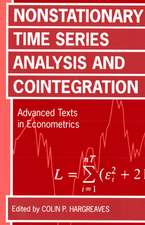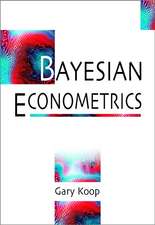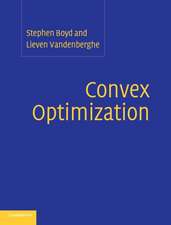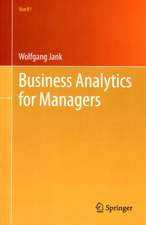Spatial Data Configuration in Statistical Analysis of Regional Economic and Related Problems: Advanced Studies in Theoretical and Applied Econometrics, cartea 14
Autor Giuseppe Arbiaen Limba Engleză Hardback – 31 mai 1989
| Toate formatele și edițiile | Preț | Express |
|---|---|---|
| Paperback (1) | 943.57 lei 6-8 săpt. | |
| SPRINGER NETHERLANDS – 21 apr 2014 | 943.57 lei 6-8 săpt. | |
| Hardback (1) | 950.03 lei 6-8 săpt. | |
| SPRINGER NETHERLANDS – 31 mai 1989 | 950.03 lei 6-8 săpt. |
Din seria Advanced Studies in Theoretical and Applied Econometrics
- 20%
 Preț: 568.83 lei
Preț: 568.83 lei - 20%
 Preț: 817.36 lei
Preț: 817.36 lei - 18%
 Preț: 809.56 lei
Preț: 809.56 lei - 24%
 Preț: 793.67 lei
Preț: 793.67 lei - 15%
 Preț: 640.06 lei
Preț: 640.06 lei -
 Preț: 383.12 lei
Preț: 383.12 lei - 18%
 Preț: 1222.62 lei
Preț: 1222.62 lei - 18%
 Preț: 950.33 lei
Preț: 950.33 lei - 15%
 Preț: 637.41 lei
Preț: 637.41 lei - 15%
 Preț: 645.79 lei
Preț: 645.79 lei -
 Preț: 387.38 lei
Preț: 387.38 lei - 18%
 Preț: 945.30 lei
Preț: 945.30 lei - 18%
 Preț: 949.73 lei
Preț: 949.73 lei -
 Preț: 386.22 lei
Preț: 386.22 lei - 18%
 Preț: 949.73 lei
Preț: 949.73 lei - 18%
 Preț: 952.40 lei
Preț: 952.40 lei - 18%
 Preț: 945.47 lei
Preț: 945.47 lei - 18%
 Preț: 954.45 lei
Preț: 954.45 lei - 18%
 Preț: 947.35 lei
Preț: 947.35 lei - 15%
 Preț: 645.60 lei
Preț: 645.60 lei - 18%
 Preț: 975.43 lei
Preț: 975.43 lei - 18%
 Preț: 1226.24 lei
Preț: 1226.24 lei -
 Preț: 392.60 lei
Preț: 392.60 lei - 15%
 Preț: 632.22 lei
Preț: 632.22 lei -
 Preț: 382.36 lei
Preț: 382.36 lei - 15%
 Preț: 642.18 lei
Preț: 642.18 lei
Preț: 950.03 lei
Preț vechi: 1158.57 lei
-18% Nou
Puncte Express: 1425
Preț estimativ în valută:
181.78€ • 189.81$ • 150.11£
181.78€ • 189.81$ • 150.11£
Carte tipărită la comandă
Livrare economică 15-29 aprilie
Preluare comenzi: 021 569.72.76
Specificații
ISBN-13: 9780792302841
ISBN-10: 0792302842
Pagini: 259
Ilustrații: XIV, 259 p.
Dimensiuni: 156 x 234 x 21 mm
Greutate: 0.58 kg
Ediția:1989
Editura: SPRINGER NETHERLANDS
Colecția Springer
Seria Advanced Studies in Theoretical and Applied Econometrics
Locul publicării:Dordrecht, Netherlands
ISBN-10: 0792302842
Pagini: 259
Ilustrații: XIV, 259 p.
Dimensiuni: 156 x 234 x 21 mm
Greutate: 0.58 kg
Ediția:1989
Editura: SPRINGER NETHERLANDS
Colecția Springer
Seria Advanced Studies in Theoretical and Applied Econometrics
Locul publicării:Dordrecht, Netherlands
Public țintă
ResearchCuprins
1. Introduction: spatial effects and the role of configuration of data.- 1.1 Objectives and approaches.- 1.2 An overview of theoretical problems.- 1.3 A sketch of the methodology.- 1.4 An outline of the book.- 1.5 Omitted topics.- 2. Theoretical Problems Motivation.- 2.1 Introduction.- 2.2 The modifiable areal unit problem.- 2.3 The ecological fallacy problem.- 2.4 Problems in the estimation of the spatial correlogram.- 2.5 Summary and conclusion.- 3. The Configuration of Spatial Data in Regional Economics.- 3.1 Introduction.- 3.2 The nature of spatial data in regional economic analysis.- 3.3 Describing the configuration of irregular collecting areas.- 3.4 Conclusion.- Appendix 3.1 FORTRAN program to generate connectivity matrices with a considerably smaller matrix as an input.- Appendix 3.2 FORTRAN program to generate grouping matrices with a considerably smaller matrix as an input.- 4. Stochastic Spatial Processes.- 4.1 Stationary stochastic processes in two dimensions.- 4.2 Linear transformations of random processes.- 4.3 Inference on spatial stochastic processes.- 4.4 Summary and conclusion.- 5. Univariate Problems: The Modifiable Areal Unit Problem.- 5.1 Introduction.- 5.2 The scale problem : regular case.- 5.3 The scale problem : irregular case.- 5.4 The aggregation problem.- 5.5 Summary and conclusion.- Appendix 5.1 FORTRAN program for the recursive estimation of variance and covariance.- Appendix 5.2 FORTRAN program for the generation of pseudo-random regular zoning systems.- 6. Biyariate Problems: The Modifiable Areal Unit Problem and Correlation between Processes.- 6.1 Introduction.- 6.2 Scale and correlation between processes.- 6.3 Aggregation and correlation between processes.- 6.4 Summary and conclusion.- 7. Biyariate Problems: The Ecological Fallacy.- 7.1Introduction.- 7.2 The ecological fallacy problem.- 7.3 Summary and conclusion.- Appendix 7.1: FORTRAN program for the generation of observations from a multivariate process with a very large variance-covariance matrix.- 8. The Dampening Effect of Spatial Correlograms.- 8.1 Introduction.- 8.2 The dampening effect.- 8.3 Simulation study.- 8.4 Summary and conclusion.- 9. Conclusion.- Appendices.- A.1 Population, employed and activity rates for local labour markets in Italy in 1981 Census.- A.2 Electricity consumption of Italian manufacturing industry in the first semester of 1985.- A.3 Quadrats counts of houses in Hukuno town, Tonami plain, Japan (Matui, 1932).- A.4 Weights of wheat plots of grain (Mercera Hall, 1911).- A.5 Simulation methods in two dimensions.- References.














